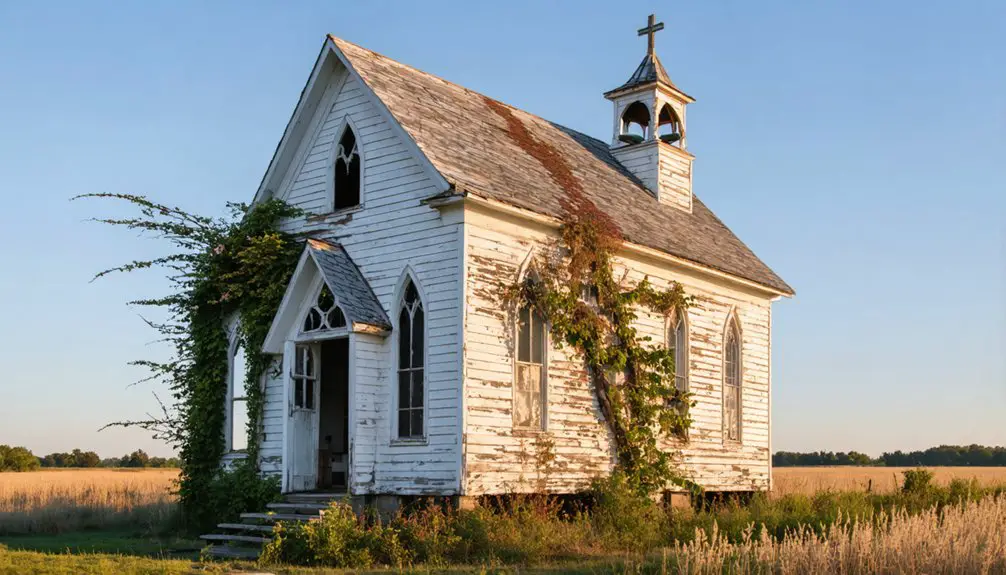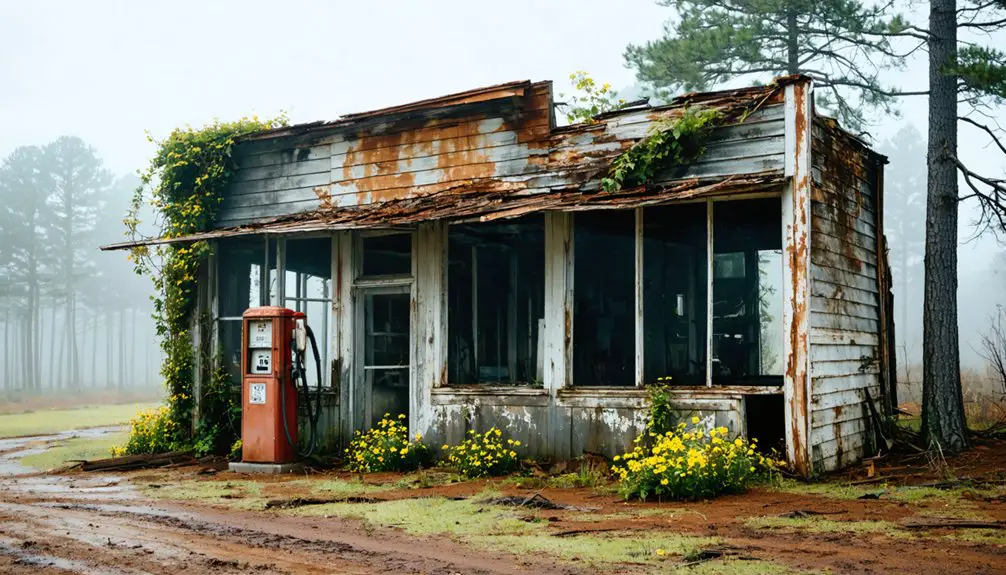The Mississippi´s name derives from a Native American Indian word meaning “great waters” or “father of waters.” The capital of Mississippi is Jackson. The state of the Union welcomed Mississippi as its 20th in 1817. It currently has a population of 2.9 million.
Mississippi has approximately 52 ghost towns throughout its territory. Mississippi has many stories and anecdotes related to its ghost towns. They are incredible stories that tell a piece of Mississippi’s history and evolution as a society.
Currently, agriculture and forestry are the primary economic industries in Mississippi. Mississippi produces more than half of the farmed catfish in the United States. It is also a sweet potato, cotton, and pulpwood-producing state. Below we invite you to join us on a journey through some of Mississippi’s ghost towns.
Prentiss, Mississippi
Prentiss (also known as Wellington) is in Bolivar County, Mississippi. Prentiss’s founding was in 1856. After the War of 1812, soldiers returning from New Orleans stopped in Wellington, and some stayed as settlers. The only way to get to Wellington was by boat; there were no roads then.
In 1838, one of the first settlers, Judge Joseph McGuire, received a contract to build a road, bought a house, and converted it into the town courthouse. Then in 1840, he made a new courthouse and jail. Wellington was a bustling river port with gambling houses and several saloons. In 1851, the town established an 18-meter right-of-way to the river. In 1852, Wellington became the county seat.
In 1856, town officials wanted to pay tribute to Congressman Sergeant Smith Prentiss, which led to the name change from Wellington to Prentiss. Prentiss’ most remarkable period of splendor was just before the beginning of the American Civil War. In this period of prosperity, the town had its newspaper, a hotel, and several residential buildings. It also had an exclusive ferry to cross the Mississippi from Vicksburg to Memphis.
In 1870 the flourishing of Prentiss ended, and it began its descent into a ghost town. In the Civil War, Confederate soldiers shot at Union soldiers hiding in the trees. After several such ambushes, Union soldiers arrived in Prentiss on a gunboat. The soldiers burned the city entirely, leaving only one small building standing after the fire.
Prentiss immediately began rebuilding. However, Union commander Thomas Oliver Selfridge dug a canal near the river to avoid further ambushes. This channel, called “Napoleon,” improved the Mississippi River for navigation because it shortened the navigation by 10 miles. Unfortunately, the river currents diverted by the Napoleon Canal caused Prentiss to be submerged entirely underwater within a few years. The city is completely submerged.
Rocky Springs, Mississippi
Rocky Springs is in Claiborne County, between Old Port Gibson Road and Natchez Trace Parkway, Mississippi. Rocky Spring was founded in 1796. Rocky Springs was a famous watering hole for travelers along the Natchez Trace, near a natural spring and rock outcropping. This community would take its name.
In 1837, Rocky Springs built a Methodist church. The first private school opened in 1838. By 1860, the town of Rocky Springs had a peak population of 2,616, plus 2,000 slaves. During its peak, the city had three merchants, four doctors, four teachers, three clergy members, and thirteen artisans. Cotton farming was the town’s primary economic source. Rocky Springs also opened a post office in 1819.
If you are wondering what event triggered Rocky Springs’s decline, the Civil War is the answer. During this period, Union battalions used this area to advance to various sites near Port Gibson. By 1878, very few people still lived in Rocky Springs. The events that drove them out of town were:
- An outbreak of yellow fever
- An infestation of weevils in their crops
- The difficulty of growing new crops in eroded soil
Thanks to all these factors, it was inevitable that Prentiss would become abandoned by 1930. The natural spring had dried up this year, and the last store went out of business.
After many years of being a ghost town, Rocky Springs allows people to take guided daily tours. The tour is relatively short, and on it, people will be able to see the relics of this town, such as a rusty tanker truck and the remains of the post office.
Visitors will see two main attractions: the Methodist church’s remaining structure and the cemetery containing the graves of the first town residents. The people organizing these tours have several signs along the way with information and historical anecdotes about the town.
Princeton, Mississippi
Princeton is in Washington County, Mississippi. Princeton’s founding was in 1820. Princeton’s name comes from settlers William Berry Prince and his wife Sarah Jefferies, who established their home near Lake Jackson. In 1830, Princeton became the second county seat of Washington County after the sinking of New Mexico under the Mississippi River. The Mississippi River flowed west of Princeton, making Princeton a natural harbor.
Mississippi state law created the Lake Washington and Deer Creek Railroad and Banking Company in 1836, with its headquarters in Princeton. Because of this, the railroad began building a line east of town. The purpose was to move the cotton from the railroad to Princeton.
They only made part of the railroad bed because the authorities revoked the company’s permit in 1839. Richard Ward was one of the first settlers of Washington County. He amassed a considerable fortune in hemp, cotton, mercantile, and shipping businesses.
Princeton’s most flourishing era was impressive. There were nearly 600 residents, a bank, a hotel, almost a dozen stores, a livery stable, and a private school. Unfortunately, this prosperity would end in 1858. The town began to sink because of the river. People left in droves, and S. B. Lawson sold what was left of some structures and the land for $125 to the first slave who made him an offer.
Today this ghost town is within the Princeton State Wildlife Management Area. This area is rich in wildlife, making it a must-stop for many sport-hunting enthusiasts to hunt, fish, and observe the behavior of the bird species that inhabit it.
Logtown, Mississippi
Logtown belonged to Hancock County and is specifically within NASA’s John Stennis Space Center. 1805 was the official founding year of this town. Logtown was a town that depended economically on cutting down trees and then transporting the wood to its various customers.
The town’s specialization in these industries was such that entrepreneur E. G. Goddard built a sawmill in 1845, and in 1889 another investor named Weston founded the Weston Lumber Company. Over the years, this company would become the most important in its industry in the United States.
The company employed 1,200 workers, used over 20 barges, and four two-masted schooners, and supported a community of 3,000 people.
In 1906, Logtown had 500 people, two churches, two stores, and a post office.
Logtown became a ghost town in 1963. The H. Weston Lumber Company operated until 1930. By that time, no marketable lumber was left, and the town’s population declined rapidly.
When the amount of lumber fell, so did the number of people living in the town; in 1961, Logtown had only 250 inhabitants who left when a company built the Space Center.
Today what used to be Logtown is the Possum Walk Trail. This tour is an ideal hiking trail in the middle of a beautiful pine forest. While exercising, athletes can admire some remnants of the town of Logtown.
A Final Thought On Mississippi Ghost Towns
The state of Mississippi is full of history relevant to understanding the origin of many American communities. Each town we revisit provides essential glimpses into American society and tells us about its evolution.
Having the opportunity to tour some of Mississippi’s ghost towns is sure to be a fascinating experience. Mississippi is a witness and protagonist of a crucial historical epoch and the flourishing of the United States as a society.



